|
|
|
Sort Order |
|
|
|
Items / Page
|
|
|
|
|
|
|
| Srl | Item |
| 1 |
ID:
108691


|
|
|
|
|
| Publication |
2009.
|
| Summary/Abstract |
Notwithstanding predictions over the past century and a half that minorities defined in ethnic, linguistic, or cultural terms would gradually reconcile themselves to coexistence in states dominated by metropolitan cultures, difficulties arising from the mobilization of minority communities continue to be pronounced at the beginning of the twenty-first century. This article provides an overview of the extent of ethnic division in modern states, describes characteristic patterns of ethnic mobilization and focuses on a smaller set of illustrative cases that reveal many of these patterns. In this, it defines the context for a set of case studies that follow: Belgium, Spain, Northern Ireland, Bosnia and Herzegovina, Cyprus, Lebanon, South Africa, and Sri Lanka.
|
|
|
|
|
|
|
|
|
|
|
|
|
|
|
|
| 2 |
ID:
126661
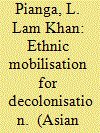

|
|
|
|
|
| Publication |
2013.
|
| Summary/Abstract |
This article attempts to communicate the methodological tension between subjectivity and objectivity by recording the aspiration of communities who are problematised both by colonialism and the modern nation-state. It highlights how colonial policy and practice contribute to the postcolonial imbroglio in Northeast India. It delineates how British colonial cartography always gave priority to 'administrative convenience' in the demarcation of boundaries, resulting in the division of ethnic community. It argues that Northeast India and the Indo-Burma borderland are not yet decolonised, as the government of India, without any rearrangement or alteration, adopts the colonial administrative boundaries, which divided ethnic communities. Neither the State Reorganisation Act (1956) nor the North-Eastern Areas (Reorganisation) Act (1971) fulfilled the aspiration of the segmented communities in the northeast, as they did in the mainland. The article also argues that the responses of the government of India towards the problems in Northeast India react to the manifested symptoms of the deep-rooted political problem rather than getting to the crux of the problem to find a solution.
|
|
|
|
|
|
|
|
|
|
|
|
|
|
|
|
| 3 |
ID:
160024
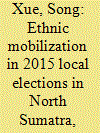

|
|
|
|
|
| Summary/Abstract |
Since Indonesia implemented the regional decentralization in 2001, ethnic politics attracted increasing scholarly attention. In the regional head elections, ethnic mobilization has become a pervasive phenomenon. Drawing upon the data in the 2015 local elections in the North Sumatra province, the article discusses two related questions, the strategy and the effect of ethnic mobilization. The article argues that, contrary to the minimum winning coalition theory, there is a weak correlation between the ethnic demography and the choice of ethnic mobilization strategy (bonding or bridging). Among all the ethnic mobilization tactics, the support of ethnic organizations may have a weak to moderate and positive impact on the voting results, while other tactics, including pairing with candidates of other ethnic groups and cultural presentations of ethnic identity, do not have much influence on the election results.
|
|
|
|
|
|
|
|
|
|
|
|
|
|
|
|
| 4 |
ID:
121833
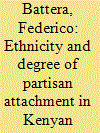

|
|
|
|
|
| Publication |
2013.
|
| Summary/Abstract |
The present analysis disaggregates election results and voter turnout according to the voters' ethnic background during a time span which covers three electoral processes (1997-2007) in Kenya. The two data combined produced an index which was called the 'degree of mobilization index'. Given that most of the Kenyan parties proved to be ethnic or made of ethnic alliances, voter turnout was found crucial in differentiating the degree of ethnic mobilization. Ethnicity alone, however, failed to explain these differences. The findings were likely linked to the past record of patronage for the five selected ethnic groups and the ability of such groups to provide a cohesive ethnic leadership.
|
|
|
|
|
|
|
|
|
|
|
|
|
|
|
|
| 5 |
ID:
160132
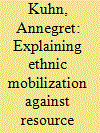

|
|
|
|
|
| Summary/Abstract |
The causal mechanisms linking natural resources and ethnic mobilization remain highly contested in the literature. Using novel data generated from interviews with ethnic representatives in Bolivia, the article addresses this research gap by combining a most similar systems design comparison of two local cases with a deviant case analysis. Results indicate that while resource-related grievances are a necessary motive for contention in terms of resource extraction, they have to concur with opportunity factors in the sense of strong local organizational capacities. Both explanatory conditions are, moreover, necessarily embedded in contentious collective action frames of a noncompliant and discriminatory state.
|
|
|
|
|
|
|
|
|
|
|
|
|
|
|
|
| 6 |
ID:
089039
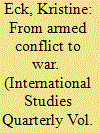

|
|
|
|
|
| Publication |
2009.
|
| Summary/Abstract |
This article presents a new line of inquiry into ethnicity and armed conflict, asking the question: are conflicts in which rebels mobilize along ethnic lines more likely to see intensified violence than nonethnically mobilized conflicts? The article argues that the ascriptive nature of ethnicity eases the identification of potential rebels and facilitates a rebel group's growth, leading to an increased risk for war. This proposition is empirically tested using a Cox model on all intrastate armed conflicts 1946-2004; the results show that ethnically mobilized armed conflicts have a 92 percent higher risk for intensification to war. In extending the analysis, the study finds that the vast majority of conflicts intensified in the first year, but for every year a low-scale conflict remained active thereafter, the risk of intensification increased, peaking around year 12.
|
|
|
|
|
|
|
|
|
|
|
|
|
|
|
|
| 7 |
ID:
156553
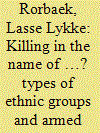

|
|
|
|
|
| Summary/Abstract |
This paper asks whether certain types of ethnic groups are particularly likely to take part in armed conflict. Several theoretical arguments indicate that this should be the case, often highlighting religious and racial boundaries as being more conflict-prone than, for instance, linguistic boundaries. However, the potential effects of groups being mobilized around these different boundary markers remain largely untested. The paper helps to fill this gap by analyzing conflict propensity across types of ethnic groups in a global sample for the period 1946–2009. At odds with common perceptions, the results show that the probability of armed conflict onset is not affected by whether ethnic groups are mobilized around religious, linguistic, racial, or regional markers. The effect of political discrimination on armed conflict is also not conditioned by these different boundary markers. The paper thus lends support to an inclusive conception of ethnicity and suggests that we need to focus on the social and political context rather than the specific cultural content of ethnic boundaries if we want to identify the conflicts that are most likely to escalate and turn violent.
|
|
|
|
|
|
|
|
|
|
|
|
|
|
|
|
| 8 |
ID:
165725
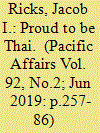

|
|
|
|
|
| Summary/Abstract |
In contrast to the veneer of a homogenous state-approved Thai ethnicity, Thailand is home to a heterogeneous population. Only about one-third of Thailand’s inhabitants speak the national language as their mother tongue; multiple alternate ethnolinguistic groups comprise the remainder of the population, with the Lao in the northeast, often called Isan people, being the largest at 28 percent of the population. Ethnic divisions closely align with areas of political party strength; the Thai Rak Thai Party and its subsequent incarnations enjoy strong support from Isan people and Khammuang speakers in the north while the Democrat Party dominates among the Thai- and Paktay-speaking people of the central plains and the south. Despite this confluence of ethnicity and political party support, we see very little mobilization along ethnic cleavages. Why? I argue that ethnic mobilization remains minimal because of the large-scale public acceptance and embrace of the government-approved Thai identity. Even among the country’s most disadvantaged, as are Isan people, support is still strong for “Thai-ness.” Most inhabitants of Thailand espouse the mantra that to be Thai is superior to being labelled as an alternate ethnic group. I demonstrate this through the application of large-scale survey data as well as a set of interviews with self-identified Isan people. The findings suggest that the Thai state has successfully inculcated a sense of national identity among the Isan people and that ethnic mobilization is hindered by ardent nationalism.
|
|
|
|
|
|
|
|
|
|
|
|
|
|
|
|
|
|
|
|
|